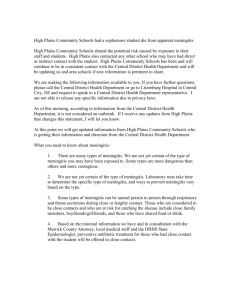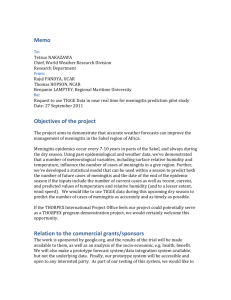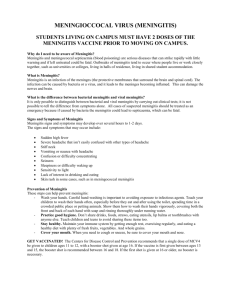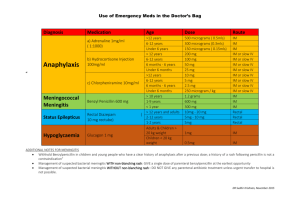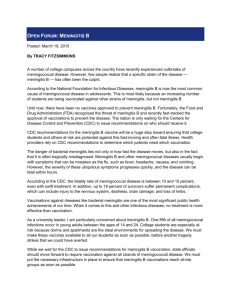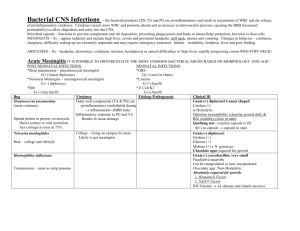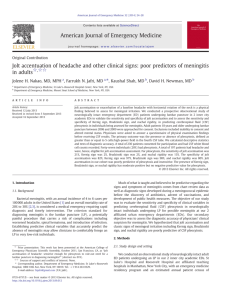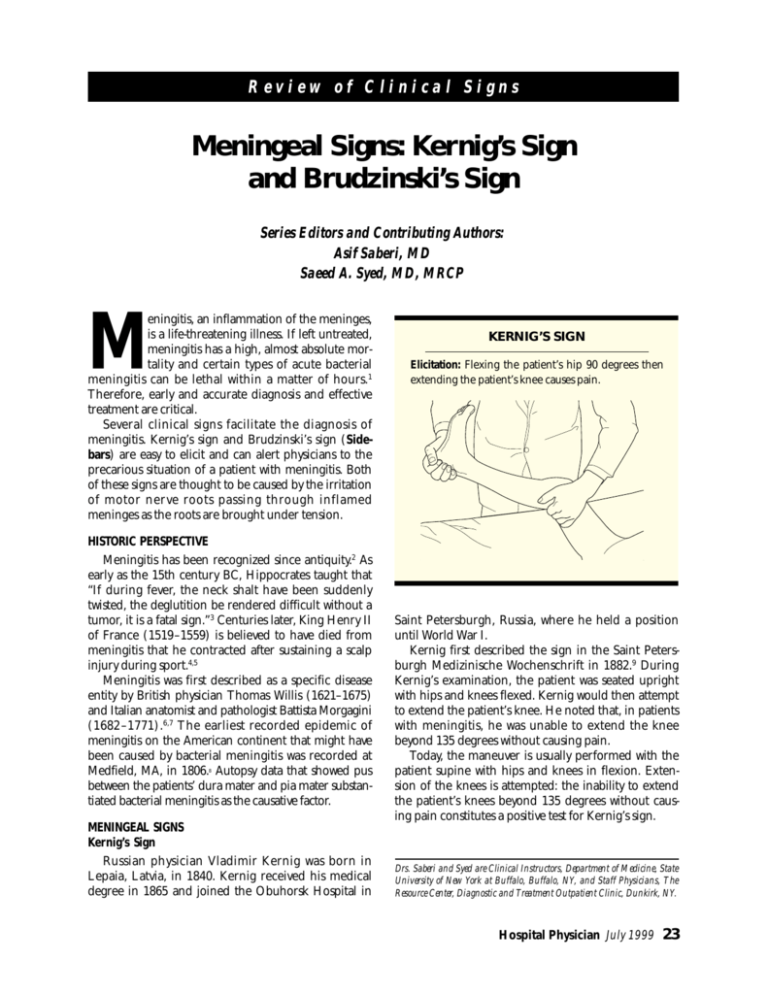
Review of Clinical Signs
Meningeal Signs: Kernig’s Sign
and Brudzinski’s Sign
Series Editors and Contributing Authors:
Asif Saberi, MD
Saeed A. Syed, MD, MRCP
eningitis, an inflammation of the meninges,
is a life-threatening illness. If left untreated,
meningitis has a high, almost absolute mortality and certain types of acute bacterial
meningitis can be lethal within a matter of hours.1
Therefore, early and accurate diagnosis and effective
treatment are critical.
Several clinical signs facilitate the diagnosis of
meningitis. Kernig’s sign and Brudzinski’s sign (Sidebars) are easy to elicit and can alert physicians to the
precarious situation of a patient with meningitis. Both
of these signs are thought to be caused by the irritation
of motor nerve roots passing through inflamed
meninges as the roots are brought under tension.
M
HISTORIC PERSPECTIVE
Meningitis has been recognized since antiquity.2 As
early as the 15th century BC, Hippocrates taught that
“If during fever, the neck shalt have been suddenly
twisted, the deglutition be rendered difficult without a
tumor, it is a fatal sign.”3 Centuries later, King Henry II
of France (1519–1559) is believed to have died from
meningitis that he contracted after sustaining a scalp
injury during sport.4,5
Meningitis was first described as a specific disease
entity by British physician Thomas Willis (1621–1675)
and Italian anatomist and pathologist Battista Morgagini
(1682–1771).6,7 The earliest recorded epidemic of
meningitis on the American continent that might have
been caused by bacterial meningitis was recorded at
Medfield, MA, in 1806. Autopsy data that showed pus
between the patients’ dura mater and pia mater substantiated bacterial meningitis as the causative factor.
8
MENINGEAL SIGNS
Kernig’s Sign
Russian physician Vladimir Kernig was born in
Lepaia, Latvia, in 1840. Kernig received his medical
degree in 1865 and joined the Obuhorsk Hospital in
KERNIG’S SIGN
Elicitation: Flexing the patient’s hip 90 degrees then
extending the patient’s knee causes pain.
Saint Petersburgh, Russia, where he held a position
until World War I.
Kernig first described the sign in the Saint Petersburgh Medizinische Wochenschrift in 1882.9 During
Kernig’s examination, the patient was seated upright
with hips and knees flexed. Kernig would then attempt
to extend the patient’s knee. He noted that, in patients
with meningitis, he was unable to extend the knee
beyond 135 degrees without causing pain.
Today, the maneuver is usually performed with the
patient supine with hips and knees in flexion. Extension of the knees is attempted: the inability to extend
the patient’s knees beyond 135 degrees without causing pain constitutes a positive test for Kernig’s sign.
Drs. Saberi and Syed are Clinical Instructors, Department of Medicine, State
University of New York at Buffalo, Buffalo, NY, and Staff Physicians, The
Resource Center, Diagnostic and Treatment Outpatient Clinic, Dunkirk, NY.
Hospital Physician July 1999
23
Saberi & Syed : Meningeal Signs : pp. 23—24
BRUDZINSKI’S NECK SIGN
Elicitation: Flexing the patient’s neck causes flexion of
the patient’s hips and knees.
Brudzinski’s Sign
Jozef Brudzinski, a Polish physician in the early 20th
century, became the dean of the University of Warsaw
(Warsaw, Poland) and chief physician at the Hospital
of Karl and Maria (Warsaw, Poland). By the beginning
of the 20th century, Kernig’s sign was well known and
in widespread use in the medical community. However,
Brudzinski’s contribution to the understanding of
meningeal signs is unique because Brudzinski used animal experiments to study the signs he elicited in
patients with meningitis.10,11
Brudzinski’s neck sign. Brudzinski actually described several different signs in patients with meningitis. Brudzinski’s neck sign is most commonly recognized and is often simply referred to as Brudzinski’s sign.
With the patient supine, the physician places one
hand behind the patient’s head and places the other
hand on the patient’s chest. The physician then raises
the patient’s head (with the hand behind the head)
while the hand on the chest restrains the patient and
prevents the patient from rising. Flexion of the
patient’s lower extremities (hips and knees) constitutes
a positive sign. Brudzinski’s neck sign has more sensitivity than Kernig’s sign.10
Brudzinski’s contralateral reflex sign. Brudzinski’s
contralateral reflex sign has two components: the identical and reciprocal contralateral reflux. The patient’s
hip and knee are passively flexed on one side; if the
contralateral leg bends in reflex, identical contralateral
reflex is demonstrated. Reciprocal contralateral reflex
occurs when the leg that has flexed in response to the
passive flexion of the contralateral hip and knee begins
to extend passively.
SUMMARY
The importance of early recognition and treatment
of meningitis cannot be overemphasized. With all the
technological advances today, the medical community
has yet to discover an economical, readily available
screening test to supplant these easy-to-elicit physical
signs. A positive result on these tests is an indication for
the institution of antibiotic therapy, and treatment initiation need not be delayed until the performance of a
lumbar puncture and receipt of the results. Overall
mortality is still high, but with appropriate and timely
treatment, most adult patients recover from meningitis
and lead a normal life. Children recovering from
meningitis occasionally experience sequelae such as
hearing loss or cranial nerve deficit. These tests for
meningitis are appropriately named to honor Kernig
and Brudzinski, both of whom greatly contributed to
medicine by facilitating the diagnosis of this life-threatening disease.
HP
REFERENCES
1. Berkow R, ed: The Merck Manual, 16th ed. Rahway, NJ:
Merck Research Laboratories, 1992:1466–1467.
2. Verghese A, Gallemore G: Kernig’s and Brudzinski’s
signs revisited. Rev Infect Dis 1987;9:1187–1192.
3. Sigerist HE: A History of Medicine, vol 2. New York:
Oxford University Press, 1961.
4. Encyclopaedia Britannica, vol 3, 15th ed. Chicago: Encyclopaedia Britannica, Inc, 1993:842.
5. Bendiner E: Andreas Vesalius: man of mystery in life
and death. Hosp Pract (Off Ed) 1986;21:202–204.
6. Thomas Willis. Encyclopaedia Britannica Online. Available
at:http://members.eb.com/bol/topic?eu=79154&sctn=
1>. Accessed June 2, 1999.
7. Encyclopaedia Britannica, vol 3, 15th ed. Chicago: Encyclopaedia Britannica, Inc, 1993:31/8.
8. Danielson L, Mann E: The history of a singular and very
mortal disease, which made its appearance in Medfield.
Medical and Agricultural Register 1806;1:65–69.
9. Kernig VM: Ueber ein kankheits symptom der acuten
meningitis. St. Petersburgh Medizinische Woschenschrift
1882;7:398.
10. Brudzinski J: Un sign nouveau sur les membres inferieurs
dans les meningitis chez les infants (sign de la nuque).
Archives de la Medicine Enfant 1910;12:745–752.
11. Brudzinski J: Ueber neue symptome von gehirnhautentizundung und reizung bei kindren, ins besondree bei
tuberkulosen. Berliner Klinische Wochenschrift 1916;53:
686–690.
Copyright 1999 by Turner White Communications Inc., Wayne, PA. All rights reserved.
24 Hospital Physician July 1999

